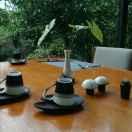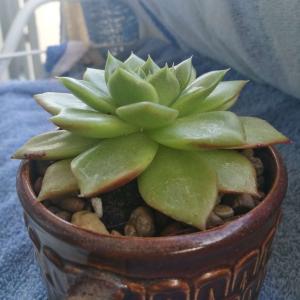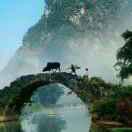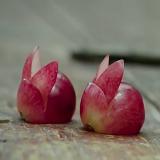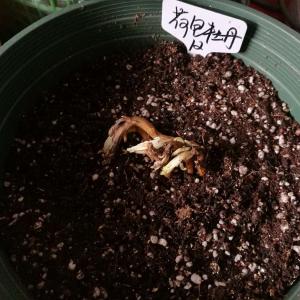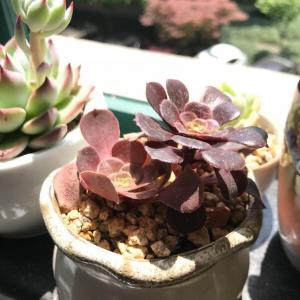文章
Miss Chen
2018年04月22日

Description: This herbaceous perennial plant is 1-3' tall, branching sparingly. The stems are round, hairless, and dull green to reddish brown. They may be slightly glaucous. The larger leaves are doubly compound, while the smaller upper leaves may be singly compound. They are arranged alternately along the stems. In each compound leaf, the leaflets form groups of three (trifoliate). A lower compound leaf may be 12" long and 6" across, while the upper compound leaves are much smaller. There is a sheath at the base of each compound leaf. A typical leaflet is about 1" long and ½" across. It is dull green with a smooth surface and edges, and oval, ovate, or oblanceolate in shape. The terminal leaflet has a conspicuous petiole, while the side leaflets are usually sessile, or nearly so. Some of the upper stems terminate in compound umbels of tiny yellow flowers. When fully mature, a compound umbel will span about 4-7" and consist of about 12-15 umbellets. The umbellets will be widely spaced, giving the compound umbel and airy appearance. Each umbellet will consist of about 12 flowers. Each flower is less than 1/8" (3 mm.) across and has 5 yellow petals. The blooming period occurs during late spring or early summer and lasts about one month. There is no noticeable floral scent. Each flower is eventually replaced by a 5-angled fruit. The root system consists of taproot.
Cultivation: The preference is partial sun and dry conditions. Poor soil is preferred, consisting of clay, rocky material, or some sand, as this reduces the competition from other plants. This plant adapts well to slopes, although it may not remain very erect. Disease doesn't appear to disfigure the foliage very often. Drought resistance is very good.
Range & Habitat: The native Yellow Pimpernel occurs occasionally in northern and central Illinois, but is uncommon or absent in southern Illinois (see Distribution Map). Habitats include dry upland prairies, edges of hill prairies, upland savannas, rocky upland forests, bluffs, areas along woodland paths, eroded clay banks in semi-shaded areas, and thickets. This plant typically occurs at the edge of dry wooded areas, especially where slopes occur.
Faunal Associations: The flowers attract small bees, wasps (including parasitic wasps), flies, and beetles. These insects seek nectar primarily, although some bees may collect pollen and some flies and beetles may feed on pollen. Some of the fly visitors include Syrphid flies, Tachinid flies, Chloropid flies, March flies, and Blow flies, while bee visitors include Nomadine bees, Little Carpenter bees, Halictid bees, Carder bees, and Andrenid bees. The caterpillars of the butterflies Papilio polyxenes asterias (Black Swallowtail) and Papilio joanae (Ozark Swallowtail) feed on the foliage of this plant; the latter insect has not been observed in Illinois, although it has been found in Missouri and western Kentucky. Little information is available about this plant's relationships to birds and mammals as a possible food source.

Photographic Location: The photographs were taken along a path in an upland woodland near Charleston, Illinois, and at the edge of a hill prairie in Vermilion County, Illinois.
Comments: Among members of the Carrot family, Yellow Pimpernel has an unusual appearance because the leaflets lack any lobes or teeth. This makes the species easy to identify in the field. Also, the compound umbels are unusually open and airy in appearance. This member of the Carrot family is rarely seen in cultivation, but should be grown more often as the tiny flowers attract many beneficial insects.
Cultivation: The preference is partial sun and dry conditions. Poor soil is preferred, consisting of clay, rocky material, or some sand, as this reduces the competition from other plants. This plant adapts well to slopes, although it may not remain very erect. Disease doesn't appear to disfigure the foliage very often. Drought resistance is very good.
Range & Habitat: The native Yellow Pimpernel occurs occasionally in northern and central Illinois, but is uncommon or absent in southern Illinois (see Distribution Map). Habitats include dry upland prairies, edges of hill prairies, upland savannas, rocky upland forests, bluffs, areas along woodland paths, eroded clay banks in semi-shaded areas, and thickets. This plant typically occurs at the edge of dry wooded areas, especially where slopes occur.
Faunal Associations: The flowers attract small bees, wasps (including parasitic wasps), flies, and beetles. These insects seek nectar primarily, although some bees may collect pollen and some flies and beetles may feed on pollen. Some of the fly visitors include Syrphid flies, Tachinid flies, Chloropid flies, March flies, and Blow flies, while bee visitors include Nomadine bees, Little Carpenter bees, Halictid bees, Carder bees, and Andrenid bees. The caterpillars of the butterflies Papilio polyxenes asterias (Black Swallowtail) and Papilio joanae (Ozark Swallowtail) feed on the foliage of this plant; the latter insect has not been observed in Illinois, although it has been found in Missouri and western Kentucky. Little information is available about this plant's relationships to birds and mammals as a possible food source.

Photographic Location: The photographs were taken along a path in an upland woodland near Charleston, Illinois, and at the edge of a hill prairie in Vermilion County, Illinois.
Comments: Among members of the Carrot family, Yellow Pimpernel has an unusual appearance because the leaflets lack any lobes or teeth. This makes the species easy to identify in the field. Also, the compound umbels are unusually open and airy in appearance. This member of the Carrot family is rarely seen in cultivation, but should be grown more often as the tiny flowers attract many beneficial insects.
0
0
文章
Miss Chen
2018年04月22日

Description: This perennial herbaceous plant forms a semi-evergreen rosette of basal leaves up to 10" across. During the spring, this plant bolts, producing one or more erect to ascending stems with alternate leaves; these stems are 1½–3½' long. The stems are light green or yellowish green, terete, and somewhat brittle; they are usually glabrous below, while above they usually have hairs that are arranged in lines. The basal leaves and lower alternate leaves are up to 5" long and 2" across (excluding their petioles); they are cordate to ovate in shape and slightly to strongly toothed along their margins. The petioles of these leaves are winged and up to 5" long (usually shorter for the lower alternate leaves than basal leaves). As the alternate leaves ascend their stems, they become smaller in size, more narrow in shape (lanceolate-ovate to elliptic), and their winged petioles gradually become shorter.
Uppermost alternate leaves are often sessile or nearly so. The middle to uppermost alternate leaves have margins that are slightly toothed or toothless (entire). The teeth of all leaves, when they are present, are crenate to serrate. The upper leaf surface is dull medium green and sparsely covered with short stiff hairs, while the lower leaf surface is hairy primarily along the major veins. With age, some leaves may lose their hairs. The central stem and any upper secondary stems terminate in panicles of flowerheads about ½–1½' long and about one-half to one-third as much across. Together, these inflorescences often resemble a compound panicle of flowerheads. Individual flowerheads are about ½" (12 mm.) across, consisting of 8-12 pistillate ray florets that surround a dense head of 10-15 perfect disk florets. The petaloid rays are widely spreading, narrowly oblong in shape, and usually white (rarely lavender). The corollas of the disk florets are up to 5 mm. (nearly ¼") long and narrowly tubular with 5 uppers lobes; they are initially yellow, but later become pink or light purple.

The base of each flowerhead is surrounded by phyllaries (scale-like floral bracts) in several overlapping series. Individual phyllaries are greenish, linear-lanceolate in shape, and variable in size; they are appressed together or slightly spreading. The midsections of these phyllaries are dark green and linear in shape throughout; the tips of these phyllaries taper gradually into narrow stiff tips. The branches of each inflorescence and peduncles of the flowerheads are light green and sparsely hairy. Along the branches of each inflorescence, there are leafy bracts up to 1" long that are linear to narrowly elliptic in shape. The blooming period occurs from late summer to mid-autumn, lasting about 1 month for a colony of plants. Afterwards, the florets are replaced by achenes with small tufts of whitish hair; they are distributed by the wind. Individual achenes are about 2 mm. long, ellipsoid-oblongoid, slightly compressed, purplish brown or brown, and longitudinally ribbed. The root system is fibrous and short-rhizomatous; older plants often develop a small woody caudex. Sometimes, clonal offsets develop from the rhizomes.
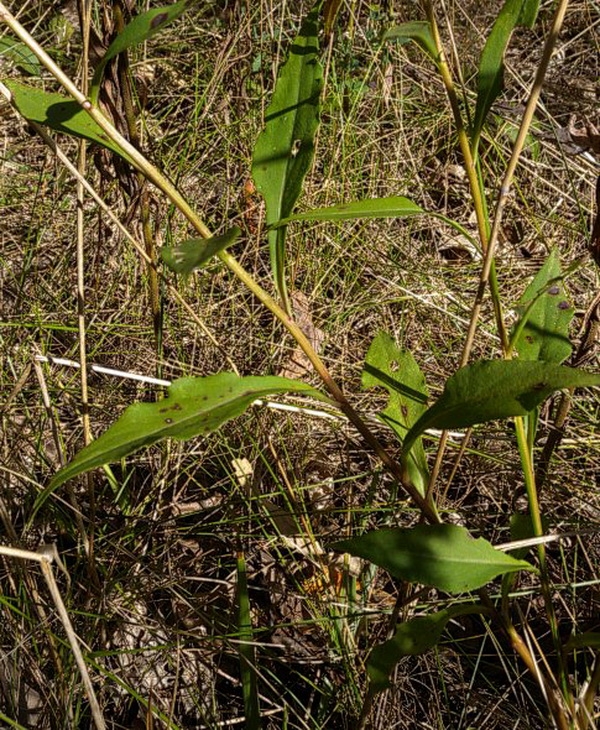
Cultivation: This plant prefers full or partial sunlight and mesic to dry conditions. A variety of soil types are tolerated, including those that contain loam, clay-loam, sandy-loam, or rocky material. This plant is not difficult to cultivate, although it should be watered during hot dry spells of the summer.
Range & Habitat: White Arrowleaf Aster is occasional throughout Illinois (see Distribution Map). This map is derived from information in Jones (1989). Habitats include upland savannas, sandy savannas, woodland edges, small meadows in upland areas, rocky glades, thickets, abandoned fields, roadsides, and areas near railroads. This plant is found in both high quality and disturbed habitats. It probably benefits from occasional fires in wooded areas, or other kinds of disturbance that thin-out the tree canopy.

Faunal Associations: The nectar and pollen of the flowerheads attract a wide variety of insects, including long-tongued bees, short-tongued bees, bee flies (Bombyliidae), wasps, butterflies, and skippers. Aster species (Symphyotrichum spp.) require cross-pollination from these insects in order to produce fertile seeds. The caterpillars of a butterfly, Phyciodes tharos (Pearl Crescent), feed on the leaves of asters, especially smooth-leaved species. Many moth species feed on the foliage and other parts of asters (see Moth Table), as do many other insects (see Insect Table), including leaf beetles, lace bugs, plant bugs, stink bugs, aphids, leafhoppers, larvae of leaf-mining flies, and larvae of fruit flies. Some vertebrate animals use aster species as a source of food. For example, the Wild Turkey and Ruffed Grouse feed on the seeds and young foliage. Deer, rabbits, groundhogs, and many domesticated farm animals also feed on the foliage, particularly when it is young.
Photographic Location: An upland meadow at Moraine View State Park in McLean County, Illinois.

Comments: White Arrowleaf Aster has a history of taxonomic instability. It has been regarded as a variety of Symphyotrichum cordifolium (Heart-leaved Aster) and Symphyotrichum sagittifolium (Arrow-leaved Aster) in the past. It is also similar to Symphyotrichum drummondii (Drummond's Aster). Some taxonomists consider Symphyotrichum sagittifolium to be a synonym for Symphyotrichum urophyllum, however A.G. Jones (1989) ultimately separated them taxonomically. White Arrowleaf Aster can be considered distinct from the preceding aster species in this group by the following characteristics: 1) the petaloid rays of this aster are usually white, rather than lavender, 2) the alternate leaves of this aster tend to be more narrow in shape, 3) the phyllaries of this aster have midsections that are dark green and linear in shape throughout their length, rather than narrowly diamond-shaped and dark green toward their tips, and 4) the phyllaries of this aster tend to have tips that are more tapered and stiff. White Arrowleaf Aster is also less hairy than Drummond's Aster. A scientific synonym of White Arrowleaf Aster is Aster urophyllus.
Uppermost alternate leaves are often sessile or nearly so. The middle to uppermost alternate leaves have margins that are slightly toothed or toothless (entire). The teeth of all leaves, when they are present, are crenate to serrate. The upper leaf surface is dull medium green and sparsely covered with short stiff hairs, while the lower leaf surface is hairy primarily along the major veins. With age, some leaves may lose their hairs. The central stem and any upper secondary stems terminate in panicles of flowerheads about ½–1½' long and about one-half to one-third as much across. Together, these inflorescences often resemble a compound panicle of flowerheads. Individual flowerheads are about ½" (12 mm.) across, consisting of 8-12 pistillate ray florets that surround a dense head of 10-15 perfect disk florets. The petaloid rays are widely spreading, narrowly oblong in shape, and usually white (rarely lavender). The corollas of the disk florets are up to 5 mm. (nearly ¼") long and narrowly tubular with 5 uppers lobes; they are initially yellow, but later become pink or light purple.

The base of each flowerhead is surrounded by phyllaries (scale-like floral bracts) in several overlapping series. Individual phyllaries are greenish, linear-lanceolate in shape, and variable in size; they are appressed together or slightly spreading. The midsections of these phyllaries are dark green and linear in shape throughout; the tips of these phyllaries taper gradually into narrow stiff tips. The branches of each inflorescence and peduncles of the flowerheads are light green and sparsely hairy. Along the branches of each inflorescence, there are leafy bracts up to 1" long that are linear to narrowly elliptic in shape. The blooming period occurs from late summer to mid-autumn, lasting about 1 month for a colony of plants. Afterwards, the florets are replaced by achenes with small tufts of whitish hair; they are distributed by the wind. Individual achenes are about 2 mm. long, ellipsoid-oblongoid, slightly compressed, purplish brown or brown, and longitudinally ribbed. The root system is fibrous and short-rhizomatous; older plants often develop a small woody caudex. Sometimes, clonal offsets develop from the rhizomes.

Cultivation: This plant prefers full or partial sunlight and mesic to dry conditions. A variety of soil types are tolerated, including those that contain loam, clay-loam, sandy-loam, or rocky material. This plant is not difficult to cultivate, although it should be watered during hot dry spells of the summer.
Range & Habitat: White Arrowleaf Aster is occasional throughout Illinois (see Distribution Map). This map is derived from information in Jones (1989). Habitats include upland savannas, sandy savannas, woodland edges, small meadows in upland areas, rocky glades, thickets, abandoned fields, roadsides, and areas near railroads. This plant is found in both high quality and disturbed habitats. It probably benefits from occasional fires in wooded areas, or other kinds of disturbance that thin-out the tree canopy.

Faunal Associations: The nectar and pollen of the flowerheads attract a wide variety of insects, including long-tongued bees, short-tongued bees, bee flies (Bombyliidae), wasps, butterflies, and skippers. Aster species (Symphyotrichum spp.) require cross-pollination from these insects in order to produce fertile seeds. The caterpillars of a butterfly, Phyciodes tharos (Pearl Crescent), feed on the leaves of asters, especially smooth-leaved species. Many moth species feed on the foliage and other parts of asters (see Moth Table), as do many other insects (see Insect Table), including leaf beetles, lace bugs, plant bugs, stink bugs, aphids, leafhoppers, larvae of leaf-mining flies, and larvae of fruit flies. Some vertebrate animals use aster species as a source of food. For example, the Wild Turkey and Ruffed Grouse feed on the seeds and young foliage. Deer, rabbits, groundhogs, and many domesticated farm animals also feed on the foliage, particularly when it is young.
Photographic Location: An upland meadow at Moraine View State Park in McLean County, Illinois.

Comments: White Arrowleaf Aster has a history of taxonomic instability. It has been regarded as a variety of Symphyotrichum cordifolium (Heart-leaved Aster) and Symphyotrichum sagittifolium (Arrow-leaved Aster) in the past. It is also similar to Symphyotrichum drummondii (Drummond's Aster). Some taxonomists consider Symphyotrichum sagittifolium to be a synonym for Symphyotrichum urophyllum, however A.G. Jones (1989) ultimately separated them taxonomically. White Arrowleaf Aster can be considered distinct from the preceding aster species in this group by the following characteristics: 1) the petaloid rays of this aster are usually white, rather than lavender, 2) the alternate leaves of this aster tend to be more narrow in shape, 3) the phyllaries of this aster have midsections that are dark green and linear in shape throughout their length, rather than narrowly diamond-shaped and dark green toward their tips, and 4) the phyllaries of this aster tend to have tips that are more tapered and stiff. White Arrowleaf Aster is also less hairy than Drummond's Aster. A scientific synonym of White Arrowleaf Aster is Aster urophyllus.
0
0
文章
Miss Chen
2018年04月22日

Description: This perennial wildflower is 1½–3' tall and more or less erect, forming occasional side branches. The stems usually have lines of hair, although sometimes they are glabrous; young stems are light to medium green, while older stems become brown. The alternate leaves along these stems are up to 4" long and ¾" across; they are narrowly ovate, lanceolate, or oblanceolate, smooth along the margins, and sessile. The upper surface of each leaf is dark green and hairless. The central stem terminates in a panicle of flowerheads that is usually longer than wide; some of the side stems also produce flowerheads in smaller panicles. The branches of each panicle are stiffly ascending; they are covered with small scale-like bracts. Each flowerhead is about ¾–1½" across, consisting of 15-25 ray florets and a similar number of disk florets. The ray florets are lavender to blue-violet, while the disk florets are yellow to reddish purple. Both kinds of florets are fertile. The base of each mature flowerhead (the involucre) is often shaped like a top or turban (turbinate) and it is about 7-11 mm. in length. The exterior of the involucre is covered with appressed scales (phyllaries) in several series; the apex of each scale is obtuse, rather than pointed. The blooming period occurs during early to mid-fall and lasts about 3 weeks. Each floret is replaced by an achene with a tuft of tawny hairs. This small achene is oblongoid with several ribs and often finely pubescent. On mature plants, the root system consists of a woody caudex with fibrous roots underneath. Occasionally, rhizomes are produced that can form vegetative offsets.
Cultivation: The preference is partial sun, mesic to slightly dry conditions, and a loamy or rocky soil with a somewhat acidic pH. The lower leaves often become withered or discolored before the blooming period occurs during the fall. If this wildflower is spoiled in the garden with fertilizer and too much water, it may become top-heavy and require staking later in the year.
Range & Habitat: The native Turbinate Aster is occasional in the southern half of Illinois and absent in the northern half of the state (see Distribution Map). Illinois lies in the NE corner of its range in the United States. Habitats include prairies, savannas, openings in upland woodlands, borders of upland woodlands, thinly wooded slopes and bluffs, cliffs, rocky glades, and roadsides. This species is often found where sandstone, chert, or granite is close to the surface of the ground.
Faunal Associations: The nectar and pollen of the flowers attract various bees, bee flies, butterflies, skippers, and other insects. Bee visitors include honeybees, bumblebees, leaf-cutting bees (Megachile spp.), digger bees (Melissodes spp.), and Halictid bees. The caterpillars of the butterflies Chlosyne nycteis (Silvery Checkerspot) and Phyciodes tharos (Pearl Crescent) feed on the foliage of asters (Symphyotrichum spp.); the caterpillars of many species of moths also feed on various parts of asters. Leaf Beetles that often feed on asters include Exema canadensis, Microrhopala xerene, Ophraella pilosa, and Sumitrosis inaequalis. The value of asters to vertebrate animals is somewhat limited. The Wild Turkey sometimes eats the seeds and foliage; White-Tailed Deer and the Cottontail Rabbit also eat the foliage.

Photographic Location: The wildflower garden of the webmaster in Urbana, Illinois.
Comments: This aster is one of the last wildflowers to bloom during the fall. It has attractive flowerheads that are larger than average in size; underneath these flowerheads, the stiffly ascending branches appear nearly naked because their scale-like bracts are so small. The Turbinate Aster (Symphyotrichum turbinellum) can be distinguished from other asters (Symphyotrichum spp.) as follows: 1) its flowerheads are at least ¾" across, 2) the branches of each panicle are covered with small scale-like bracts, 3) the leaves along the stems are sessile and never cordate at the base, 4) the margins of the leaves are entire or slightly crenate, 5) the tips of the phyllaries are obtuse, rather than pointed, and 6) the stems often have lines of hairs. Sometimes, this wildflower is called the Prairie Aster, but it is more common in savannas or thin upland woodlands (at least in Illinois).
Cultivation: The preference is partial sun, mesic to slightly dry conditions, and a loamy or rocky soil with a somewhat acidic pH. The lower leaves often become withered or discolored before the blooming period occurs during the fall. If this wildflower is spoiled in the garden with fertilizer and too much water, it may become top-heavy and require staking later in the year.
Range & Habitat: The native Turbinate Aster is occasional in the southern half of Illinois and absent in the northern half of the state (see Distribution Map). Illinois lies in the NE corner of its range in the United States. Habitats include prairies, savannas, openings in upland woodlands, borders of upland woodlands, thinly wooded slopes and bluffs, cliffs, rocky glades, and roadsides. This species is often found where sandstone, chert, or granite is close to the surface of the ground.
Faunal Associations: The nectar and pollen of the flowers attract various bees, bee flies, butterflies, skippers, and other insects. Bee visitors include honeybees, bumblebees, leaf-cutting bees (Megachile spp.), digger bees (Melissodes spp.), and Halictid bees. The caterpillars of the butterflies Chlosyne nycteis (Silvery Checkerspot) and Phyciodes tharos (Pearl Crescent) feed on the foliage of asters (Symphyotrichum spp.); the caterpillars of many species of moths also feed on various parts of asters. Leaf Beetles that often feed on asters include Exema canadensis, Microrhopala xerene, Ophraella pilosa, and Sumitrosis inaequalis. The value of asters to vertebrate animals is somewhat limited. The Wild Turkey sometimes eats the seeds and foliage; White-Tailed Deer and the Cottontail Rabbit also eat the foliage.

Photographic Location: The wildflower garden of the webmaster in Urbana, Illinois.
Comments: This aster is one of the last wildflowers to bloom during the fall. It has attractive flowerheads that are larger than average in size; underneath these flowerheads, the stiffly ascending branches appear nearly naked because their scale-like bracts are so small. The Turbinate Aster (Symphyotrichum turbinellum) can be distinguished from other asters (Symphyotrichum spp.) as follows: 1) its flowerheads are at least ¾" across, 2) the branches of each panicle are covered with small scale-like bracts, 3) the leaves along the stems are sessile and never cordate at the base, 4) the margins of the leaves are entire or slightly crenate, 5) the tips of the phyllaries are obtuse, rather than pointed, and 6) the stems often have lines of hairs. Sometimes, this wildflower is called the Prairie Aster, but it is more common in savannas or thin upland woodlands (at least in Illinois).
0
0
文章
Miss Chen
2018年04月22日

Description: This is a perennial plant about 1-3' tall that branches occasionally, often leaning toward one side. The stems are light green or reddish brown, and they have lines of white hairs. The alternate leaves are up to 4½" long and ½" across, becoming much smaller as they ascend the stems. They are narrowly lanceolate, oblanceolate, or elliptic, becoming linear near the flowerheads. There are usually a few teeth toward the tips of the larger leaves, otherwise they have smooth margins. Some hairs may be present along the major veins on the undersides of the leaves. The upper leaf surface is medium green, while the lower leaf surface is light green. The upper stems and some of the side stems produce panicles of flowerheads up to 10" long and 6" across. Each flowerhead has numerous small disk florets that are surrounded by about 8-12 ray florets. The corollas of the disk florets are initially pale yellow, but they later become brown or reddish purple; they are short-tubular in shape and 5-lobed. The petaloid rays are white and linear-oblong in shape. A typical flowerhead is about 1/3" (8 mm.) across. Each flowerhead is subtended by small green bracts (phyllaries) that are appressed together, or they are only slightly spreading.
The blooming period occurs from late summer to the fall, lasting about 1-2 months. There is little or no floral scent. The small achenes are slightly pubescent and they have small tufts of white hair. Distribution of the achenes is by wind. The root system is fibrous and rhizomatous; an older plant may develop a small caudex. Clonal offsets occasionally develop from the rhizomes. This plant occasionally forms colonies at favorable sites.
Cultivation: The preference is light shade to partial sun and moist conditions. Full sun is tolerated if the site is not too dry. Growth is best in rich organic soil, or a moisture retaining clay-loam. During dry weather, the lower leaves often wither away, and stressed out plants are vulnerable to many kinds of foliar disease.

Range & Habitat: The native Calico Aster occurs in most counties of Illinois, where it is native and quite common (see Distribution Map). Habitats include moist meadows near woodlands and rivers, floodplain forests and flatwoods, woodland borders, seeps and swamps, semi-shaded sloughs near fields, and moist depressions in waste areas. This plant is primarily a woodland species, but it often strays into moist sunny areas nearby. It prefers areas with a history of disturbance.
Faunal Associations: The florets of Calico Aster have shorter nectar tubes than many other species of asters, and they seem to attract a wide variety of insects, particularly in sunny areas. More common insect visitors include short-tongued bees, wasps, and flies, and less common visitors include long-tongued bees, small butterflies, skippers, beetles, and plant bugs. These insects seek nectar primarily, although the short-tongued bees may collect pollen, while some beetles and flies feed on the pollen. Caterpillars of the butterflies, Chlosyne nycteis (Silvery Checkerspot) and Phyciodes tharos (Pearl Crescent), feed on the foliage of asters (Symphyotrichum spp.), as do the caterpillars of many kinds of moths (see Moth Table). The White-Tailed Deer and Cottontail Rabbit browse on the foliage occasionally.

Photographic Location: The photographs were taken at the webmaster's wildflower garden in Urbana, Illinois.
Comments: This aster is more attractive in woodland areas, where it has a delicate appearance. It closely resembles Symphyotrichum pilosum (Frost Aster), Symphyotrichum ericoides (Heath Aster), and other species in the genus with small white flowerheads. The Calico Aster (Symphyotrichum lateriflorum) is a somewhat lanky plant with smaller flowerheads (about 1/3" or 8 mm. across) and fewer ray florets per flowerhead (about 10) than many similar asters (Symphyotrichum spp.). In this regard, it is similar to the Heath Aster, but the latter species is a more compact plant with leaves that are shorter and more narrow than those of the Calico Aster. While the Heath Aster is often found in open prairies, the Calico Aster usually doesn't stray far from woodland and semi-shaded wetland areas. Its common name refers to the diverse colors of the disk florets as they mature. Another common name of this species is the Side-Flowering Aster, and another scientific name is Aster lateriflorus.
The blooming period occurs from late summer to the fall, lasting about 1-2 months. There is little or no floral scent. The small achenes are slightly pubescent and they have small tufts of white hair. Distribution of the achenes is by wind. The root system is fibrous and rhizomatous; an older plant may develop a small caudex. Clonal offsets occasionally develop from the rhizomes. This plant occasionally forms colonies at favorable sites.
Cultivation: The preference is light shade to partial sun and moist conditions. Full sun is tolerated if the site is not too dry. Growth is best in rich organic soil, or a moisture retaining clay-loam. During dry weather, the lower leaves often wither away, and stressed out plants are vulnerable to many kinds of foliar disease.

Range & Habitat: The native Calico Aster occurs in most counties of Illinois, where it is native and quite common (see Distribution Map). Habitats include moist meadows near woodlands and rivers, floodplain forests and flatwoods, woodland borders, seeps and swamps, semi-shaded sloughs near fields, and moist depressions in waste areas. This plant is primarily a woodland species, but it often strays into moist sunny areas nearby. It prefers areas with a history of disturbance.
Faunal Associations: The florets of Calico Aster have shorter nectar tubes than many other species of asters, and they seem to attract a wide variety of insects, particularly in sunny areas. More common insect visitors include short-tongued bees, wasps, and flies, and less common visitors include long-tongued bees, small butterflies, skippers, beetles, and plant bugs. These insects seek nectar primarily, although the short-tongued bees may collect pollen, while some beetles and flies feed on the pollen. Caterpillars of the butterflies, Chlosyne nycteis (Silvery Checkerspot) and Phyciodes tharos (Pearl Crescent), feed on the foliage of asters (Symphyotrichum spp.), as do the caterpillars of many kinds of moths (see Moth Table). The White-Tailed Deer and Cottontail Rabbit browse on the foliage occasionally.

Photographic Location: The photographs were taken at the webmaster's wildflower garden in Urbana, Illinois.
Comments: This aster is more attractive in woodland areas, where it has a delicate appearance. It closely resembles Symphyotrichum pilosum (Frost Aster), Symphyotrichum ericoides (Heath Aster), and other species in the genus with small white flowerheads. The Calico Aster (Symphyotrichum lateriflorum) is a somewhat lanky plant with smaller flowerheads (about 1/3" or 8 mm. across) and fewer ray florets per flowerhead (about 10) than many similar asters (Symphyotrichum spp.). In this regard, it is similar to the Heath Aster, but the latter species is a more compact plant with leaves that are shorter and more narrow than those of the Calico Aster. While the Heath Aster is often found in open prairies, the Calico Aster usually doesn't stray far from woodland and semi-shaded wetland areas. Its common name refers to the diverse colors of the disk florets as they mature. Another common name of this species is the Side-Flowering Aster, and another scientific name is Aster lateriflorus.
0
0
文章
Miss Chen
2018年04月22日

Description: From late fall to spring, this perennial wildflower exists as a small basal rosette of leaves spanning up to 4½" across. As warmer weather arrives, it bolts, developing one or more flowering stems that are 1-3' long. These stems can be erect, ascending, or sprawling; they are sparingly branched, slender, light green, terete, and glabrous. Alternate leaves along the stems are about 1½–3" long and 1/8–1/4" (3-6 mm.) across; they are linear-lanceolate or narrowly elliptic, medium green, glabrous, and sessile. The leaf margins are either rolled inward and smooth or shallowly and sparingly toothed. Each alternate leaf has a single central vein that is prominent.
The central stem (and any lateral stems) terminates in a rather airy panicle of flowerheads about 6-9" long and a little less across. Generally, the flowerheads are more or less erect in relation to the panicle, which often leans sideways to some extent; the flowerheads are not secund (always facing upward away from the ground). The ascending branches of the panicle are slender, light green, and glabrous. Individual flowerheads develop from terminal branches that are usually ½" or more in length. Several small leafy bracts occur along the terminal branches; these bracts are linear in shape and less than ¼" in length. Larger leafy bracts can occur on non-terminal branches. Each flowerhead is about ½" across, consisting of 15-25 white ray florets and 10-20 yellow disk florets; the disk florets later become reddish purple. At the base of each flowerhead, thereDistribution Map are small appressed floral bracts in 3-5 series that surround the involucre; this involucre is 3-6 mm. long. The floral bracts have dark green tips, otherwise they are light green; these dark green tips are rhombic-obovate or rhombic-oblanceolate in shape. The blooming period occurs from late summer to early fall and lasts about 1 month. The florets are replaced by small achenes with sessile tufts of white hair, which are distributed by the wind. Individual achenes are bullet-shaped with 3-5 prominent ribs and they are pale pink to straw-colored. The root system is fibrous and rhizomatous; on an older plant, a small caudex may develop. Vegetative offsets are sometimes formed by the rhizomes.
Cultivation: The preference is full or partial sun, moist to dry-mesic conditions, and sandy soil. Individual plants may lean to the side when they bloom.
Range & Habitat: The native Rice Button Aster is an uncommon plant that is found primarily in sandy areas of NE Illinois; elsewhere in the state, it is rare or absent. Illinois lies close to the northern range limit of this species. Habitats include dry-mesic sandy savannas, interdunal swales, moist meadows, areas along sandy paths, and abandoned fields. Rather oddly, Rice Button Aster gravitates toward either fairly dry or poorly drained habitats.
Faunal Associations: The nectar and pollen of the flowerheads attract numerous insects, including long-tongued bees, short-tongued bees, wasps, flies, butterflies, skippers, and beetles. Among the bees, honeybees, bumblebees, green metallic bees, dagger bees (e.g., Calliopsis), and oligolectic Andrenid bees (e.g., Andrena asteroides) are known to visit the flowerheads of Rice Button Aster. For many of these insect visitors, Symphyotrichum spp. (Asters) are an important source of late-season nectar and pollen. Other insects feed on the foliage, suck plant juices, bore through the stalks and roots, or gnaw on the flowerheads and developing seeds. These insects include long-horned beetles, leaf beetles, aphids, leafhoppers, lace bugs, plant bugs, fly larvae (Cecidomyiidae), and caterpillars of butterflies and moths. The Wild Turkey occasionally feeds on the leaves and seedheads, while White-Tailed Deer and the Cottontail Rabbit browse on the foliage.
Photographic Location: A sandy savanna at Hooper Branch Savanna Nature Preserve in Iroquois County, Illinois.

Comments: This is one of many white-flowered asters that can be found in Illinois. Rice Button Aster is a slender and delicate-looking plant that is rather variable across its range: different varieties have been described. It is perhaps most similar in appearance to Symphyotrichum racemosum (syn. Symphyotrichum vimineum, syn. Symphyotrichum fragile), which also has small white flowerheads. The latter species differs from Rice Button Aster by its slightly smaller flowerheads (1/3" or 8 mm. across); these flowerheads are more secund (facing upward away from the ground) and they are usually produced in greater abundance. Furthermore, the terminal branches of its flowerheads are usually shorter than those of the Rice Button Aster. An alternative scientific name of Rice Button Aster is Aster dumosus.
The central stem (and any lateral stems) terminates in a rather airy panicle of flowerheads about 6-9" long and a little less across. Generally, the flowerheads are more or less erect in relation to the panicle, which often leans sideways to some extent; the flowerheads are not secund (always facing upward away from the ground). The ascending branches of the panicle are slender, light green, and glabrous. Individual flowerheads develop from terminal branches that are usually ½" or more in length. Several small leafy bracts occur along the terminal branches; these bracts are linear in shape and less than ¼" in length. Larger leafy bracts can occur on non-terminal branches. Each flowerhead is about ½" across, consisting of 15-25 white ray florets and 10-20 yellow disk florets; the disk florets later become reddish purple. At the base of each flowerhead, thereDistribution Map are small appressed floral bracts in 3-5 series that surround the involucre; this involucre is 3-6 mm. long. The floral bracts have dark green tips, otherwise they are light green; these dark green tips are rhombic-obovate or rhombic-oblanceolate in shape. The blooming period occurs from late summer to early fall and lasts about 1 month. The florets are replaced by small achenes with sessile tufts of white hair, which are distributed by the wind. Individual achenes are bullet-shaped with 3-5 prominent ribs and they are pale pink to straw-colored. The root system is fibrous and rhizomatous; on an older plant, a small caudex may develop. Vegetative offsets are sometimes formed by the rhizomes.
Cultivation: The preference is full or partial sun, moist to dry-mesic conditions, and sandy soil. Individual plants may lean to the side when they bloom.
Range & Habitat: The native Rice Button Aster is an uncommon plant that is found primarily in sandy areas of NE Illinois; elsewhere in the state, it is rare or absent. Illinois lies close to the northern range limit of this species. Habitats include dry-mesic sandy savannas, interdunal swales, moist meadows, areas along sandy paths, and abandoned fields. Rather oddly, Rice Button Aster gravitates toward either fairly dry or poorly drained habitats.
Faunal Associations: The nectar and pollen of the flowerheads attract numerous insects, including long-tongued bees, short-tongued bees, wasps, flies, butterflies, skippers, and beetles. Among the bees, honeybees, bumblebees, green metallic bees, dagger bees (e.g., Calliopsis), and oligolectic Andrenid bees (e.g., Andrena asteroides) are known to visit the flowerheads of Rice Button Aster. For many of these insect visitors, Symphyotrichum spp. (Asters) are an important source of late-season nectar and pollen. Other insects feed on the foliage, suck plant juices, bore through the stalks and roots, or gnaw on the flowerheads and developing seeds. These insects include long-horned beetles, leaf beetles, aphids, leafhoppers, lace bugs, plant bugs, fly larvae (Cecidomyiidae), and caterpillars of butterflies and moths. The Wild Turkey occasionally feeds on the leaves and seedheads, while White-Tailed Deer and the Cottontail Rabbit browse on the foliage.
Photographic Location: A sandy savanna at Hooper Branch Savanna Nature Preserve in Iroquois County, Illinois.

Comments: This is one of many white-flowered asters that can be found in Illinois. Rice Button Aster is a slender and delicate-looking plant that is rather variable across its range: different varieties have been described. It is perhaps most similar in appearance to Symphyotrichum racemosum (syn. Symphyotrichum vimineum, syn. Symphyotrichum fragile), which also has small white flowerheads. The latter species differs from Rice Button Aster by its slightly smaller flowerheads (1/3" or 8 mm. across); these flowerheads are more secund (facing upward away from the ground) and they are usually produced in greater abundance. Furthermore, the terminal branches of its flowerheads are usually shorter than those of the Rice Button Aster. An alternative scientific name of Rice Button Aster is Aster dumosus.
0
0
文章
权问薇
2018年04月20日

富贵竹为什么会黄叶?
1、无根。刚买回来的的富贵竹因为没有长根,植株养分不够,会出现黄叶的现象。
2、缺铁。缺少铁元素,富贵竹也会黄叶,一般表现为叶片嫩黄。
3、干燥。富贵竹喜欢湿润温暖的环境,如果空气过于干燥,也会导致黄叶、干尖。
4、光照。阳光太强会使富贵竹黄叶干枯;长期不见光,会导致富贵竹的新叶嫩黄,叶片无光泽。
5、不及时换水。长期不给水培的富贵竹换水,也会导致黄叶。

富贵竹黄叶了怎么办?
水培:
1、先把黄叶清理摘掉,否则会占用其他叶子的营养。
2、修根。如果根部有损坏,有烂根,要先剪掉烂根,再放入水中培养,否则会继续感染其他根系,从而导致黄叶。
3、生根的时候可以在水中放1片阿司匹林。瓶子3天换一次水,最好选用纯净水,自来水要晾晒一天再用,去除里面的氯气,15~20天能生根。
3、添加营养液。富贵竹缺铁的话,可以往水中加硫酸亚铁溶液补充铁元素,在每次换水的时候加入即可。硫酸亚铁与清水1:1000配制。
4、平时可以用喷壶往叶片上喷点水来保持湿度,或者在它周围的空气中喷水都可以。
5、富贵竹一般多都放在室内,不能接受阳光的直射,也不能处在太阴暗的地方,放在室内光线明亮的散射光处即可,比如客厅。
6、如果直接用自来水养富贵竹,水质容易腐败,自来水最好是晒一天再用,建议用纯净水或者井水。
换水的时候不必把富贵竹整个都拿出来,只需把瓶子倾斜,水倒出即可,水加到瓶子的1/2或者2/3。

土培:
1、土培的富贵竹生长速度比较缓慢,出现黄叶,一般是由于盆土的营养不充分。
2、这时候我们可以给富贵竹换个大一点的盆,准备新的土壤。
①准备一个有排水孔的,比之前的大一些的花盆。
②富贵竹喜欢湿润的环境,所以我们可以用园土和河沙1:1配制盆土,来保证透水和透气。
③把原先盆里的富贵竹清理好根部的土壤,尽量避免伤到根系,然后分开,栽进新的花盆里。
④栽好之后,给它浇透水就完成换盆了。
3、土培的富贵竹会比较怕干,一般三天左右浇一次水,叶片也要经常用喷壶喷一点水保持湿度,冬天要减少浇水次数。
4、想让富贵竹长得旺盛,可以敲碎一些鸡蛋壳放在盆土中。

怎么能让富贵竹长得快?
1、富贵竹的生长温度在20℃左右最适宜,夏天要防晒,冬天要防冻。
2、不能把富贵竹放在电视机、空调、电风扇旁边,否则会使富贵竹干尖、黄叶。可以放在沙发旁边。
3、2~3个星期换一次水,最好是纯净水,加一片甲硝唑会防止水质变臭。
4、每个月在瓶子里加两滴营养液,富贵竹会长得又快又绿。
5、刚买的富贵竹没根,要把下面45°切一刀增加接触面积,这样生根快。
6、有花友养的富贵竹还开花了呢!见识一下吧~

如果家里的富贵竹有黄叶就赶紧用上面的方法试一试吧!
1、无根。刚买回来的的富贵竹因为没有长根,植株养分不够,会出现黄叶的现象。
2、缺铁。缺少铁元素,富贵竹也会黄叶,一般表现为叶片嫩黄。
3、干燥。富贵竹喜欢湿润温暖的环境,如果空气过于干燥,也会导致黄叶、干尖。
4、光照。阳光太强会使富贵竹黄叶干枯;长期不见光,会导致富贵竹的新叶嫩黄,叶片无光泽。
5、不及时换水。长期不给水培的富贵竹换水,也会导致黄叶。

富贵竹黄叶了怎么办?
水培:
1、先把黄叶清理摘掉,否则会占用其他叶子的营养。
2、修根。如果根部有损坏,有烂根,要先剪掉烂根,再放入水中培养,否则会继续感染其他根系,从而导致黄叶。
3、生根的时候可以在水中放1片阿司匹林。瓶子3天换一次水,最好选用纯净水,自来水要晾晒一天再用,去除里面的氯气,15~20天能生根。
3、添加营养液。富贵竹缺铁的话,可以往水中加硫酸亚铁溶液补充铁元素,在每次换水的时候加入即可。硫酸亚铁与清水1:1000配制。
4、平时可以用喷壶往叶片上喷点水来保持湿度,或者在它周围的空气中喷水都可以。
5、富贵竹一般多都放在室内,不能接受阳光的直射,也不能处在太阴暗的地方,放在室内光线明亮的散射光处即可,比如客厅。
6、如果直接用自来水养富贵竹,水质容易腐败,自来水最好是晒一天再用,建议用纯净水或者井水。
换水的时候不必把富贵竹整个都拿出来,只需把瓶子倾斜,水倒出即可,水加到瓶子的1/2或者2/3。

土培:
1、土培的富贵竹生长速度比较缓慢,出现黄叶,一般是由于盆土的营养不充分。
2、这时候我们可以给富贵竹换个大一点的盆,准备新的土壤。
①准备一个有排水孔的,比之前的大一些的花盆。
②富贵竹喜欢湿润的环境,所以我们可以用园土和河沙1:1配制盆土,来保证透水和透气。
③把原先盆里的富贵竹清理好根部的土壤,尽量避免伤到根系,然后分开,栽进新的花盆里。
④栽好之后,给它浇透水就完成换盆了。
3、土培的富贵竹会比较怕干,一般三天左右浇一次水,叶片也要经常用喷壶喷一点水保持湿度,冬天要减少浇水次数。
4、想让富贵竹长得旺盛,可以敲碎一些鸡蛋壳放在盆土中。

怎么能让富贵竹长得快?
1、富贵竹的生长温度在20℃左右最适宜,夏天要防晒,冬天要防冻。
2、不能把富贵竹放在电视机、空调、电风扇旁边,否则会使富贵竹干尖、黄叶。可以放在沙发旁边。
3、2~3个星期换一次水,最好是纯净水,加一片甲硝唑会防止水质变臭。
4、每个月在瓶子里加两滴营养液,富贵竹会长得又快又绿。
5、刚买的富贵竹没根,要把下面45°切一刀增加接触面积,这样生根快。
6、有花友养的富贵竹还开花了呢!见识一下吧~

如果家里的富贵竹有黄叶就赶紧用上面的方法试一试吧!
2
2




